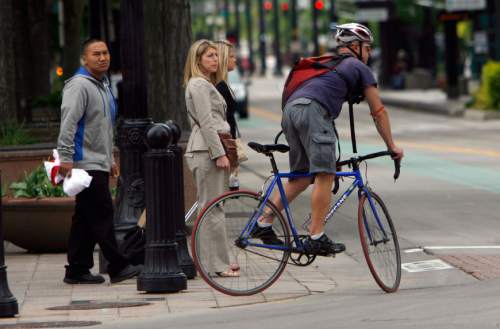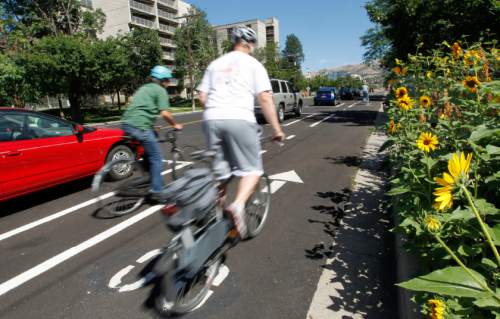This is an archived article that was published on sltrib.com in 2015, and information in the article may be outdated. It is provided only for personal research purposes and may not be reprinted.
Highways and mass transit have long been the two main pillars of regional transportation plans. But officials are now adding a third: bicycle paths, with plans to vastly expand them throughout the Wasatch Front.
That isn't the only big change in a newly proposed, once-every-four-year wfrc.org/new_wfrc/index.php/2015-rtp">update of transportation plans through 2040 for Salt Lake, Davis, Weber and part of Box Elder counties.
The Wasatch Front Regional Council blueprint also puts a heavier emphasis on maintaining and making existing highways more efficient, instead of just adding new ones. And it focuses on expanding bus routes and service hours more than on building new TRAX or streetcar lines.
The council projects that if the plan, proposed by local mayors and county commissioners on the council, is implemented, over 25 years it will reduce air pollution and the time that people spend driving — even with expected rapid population growth.
"We have made many improvements to the plan, and we're excited," said Andrew Gruber, executive director of the council. Details of the plans, including an interactive map of proposed projects, is available online at wfrc.org.
Making bike paths a main component of the new regional plan, he said, shows local officials now view cycling as something "not just for recreation, but also as a real mode for transportation."
Muriel Xochimitl, communications director for the council, said far more people now pedal to work, and improving bike paths could help provide better connections to bus and train stops.
"It's an explosion of interest," Gruber said.
The new plan includes a vast grid of proposed safer bike paths throughout the Wasatch Front. Gruber is most excited about one where "we will have a dedicated, separate bike lane from Provo to Ogden" that parallels Interstate 15 and the FrontRunner commuter rail. "How cool is that?" he said.
It would use and connect a variety of trails including the Jordan River Parkway in Salt Lake County, the Legacy Parkway in Davis County, the Denver and Rio Grande rail trail and the Ogden River trail system.
Gruber is also excited about a major proposed east-west bike trail that would stretch between the Oquirrh and Wasatch mountains along 4100/3900 South.
Jory Johner, manager of long-range planning for the council, said the road that bike path will follow already goes over or under Interstate 15 and Interstate 215, so bikers can avoid freeway interchanges.
For mass transit, Gruber said the new plan reflects the Utah Transit Authority's promise to expand bus service, including more routes and longer service hours, after recent completion of major TRAX lines.
While he said that will be a main emphasis, several new transit projects are still included in plans, but mainly are "bus rapid transit" (BRT) — sort of a TRAX on rubber wheels, where buses use bus-only lanes, tickets are sold by machines, and buses are longer and have more doors for quicker exit and entry.
Possible BRT lines in the updated regional plan include one from downtown Ogden to Weber State University; one from downtown Salt Lake City through Davis County: and in Salt Lake County along 5600 West and major east-west routes including 4100/3900 South, 4700 South, and extension of an existing BRT line on 3500 South.
Christopher Stout, president of a group calling itself the Utah Transit Riders Union, said it opposes most of the new transit projects in the plan, doubting there is demand for them. He said it would be wiser to put money into even more expanded neighborhood bus service — including more late-night and weekend service.
In regard to highways, Gruber said plans put a greater emphasis on maintaining existing ones, and finding ways to make them more efficient — in part because little room exists for new highways.
For example, the plan moves up the timetable for converting Bangerter Highway in Salt Lake County into more of a true freeway. It calls for earlier conversion of more of its intersections into freeway-like interchanges — similar to what has already happened at 7800 South and is now under construction at Redwood Road.
Gruber says that approach could speed travel not only along Bangerter, but also help traffic that must cross it.
The plans include adding even more high-occupancy vehicle express lanes on I-15, extending them from Layton to Riverdale.
It also calls for extending the Mountain View Corridor highway in the short term from 5400 South to SR-201. Over the long term, that highway would be converted in phases to a freeway and connect to I-80.
Funding all the projects in the updated plan could be a challenge. Legislators are considering raising gasoline and other taxes to cover a projected $11.3 billion shortfall through 2040 for priority projects identified in earlier studies and included in the state's 2040 Unified Transportation Plan.
The council is taking public input on the plan through Feb. 20. The public can post comments on wfrc.org. The council also has public open houses scheduled from 5:30 p.m. to 7:30 p.m. on Jan. 26 at West Valley City Hall, and on Feb. 9 at Roy City Hall. It plans an online open house from 4 p.m. to 6 p.m. on Feb. 17 at wfrc.org.
Twitter: @LeeHDavidson —
Open houses for proposed transportation plan update
• Jan. 26, 5:30 p.m. to 7:30 p.m., West Valley City Hall, 3600 S. Constitution Boulevard.
• Feb. 9, 5:30 p.m. to 7:30 p.m., Roy City Hall, 5051 S. 1900 West.
• Feb. 17, 4 p.m. to 6 p.m, online at wfrc.org.





